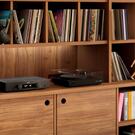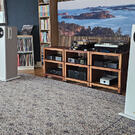A good preamplifier must of course be combined with a good power amplifier with sufficient power, good dynamics and a playing style that matches the preamplifier. It is very common that the perfect combination is not two units from the same manufacturer, but that you have to search for something that more than adequately matches the equipment already in the rack. Sometimes this creates two new problems. The sound has to match, and the design shouldn’t be miles apart. Even hi-fi enthusiasts have a small inner interior designer – although they may find it hard to admit.
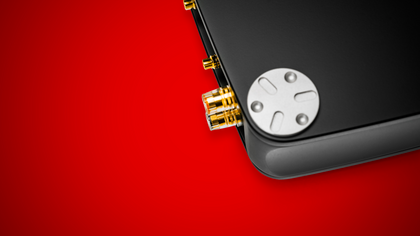
Unified design
The enclosures of C-280 and P-280 have the same design, and they are also made of the same composite material. The reasoning is the same. Metal enclosures, whether they are steel or aluminium, have a mechanical resonance that contributes hardness to the reproduction. This is a claim that many other manufacturers of serious hi-fi likely would like to discuss, but so far in the test there is nothing to indicate that Aavik is far off the mark. It is always interesting when claims have a certain resonance in the actual behaviour of a product.
It isn’t made completely without the use of aluminium, but that’s only to provide adequate cooling of the components.
As in the C-280, there is a pronounced use of so-called Tesla coils, and the principle is the same. The Tesla coils are fitted in pairs, and are wound in opposite directions. Both of the coils have voltage, and when the Tesla coil encounters a voltage spike, a counter spike is activated in the second coil to eliminate noise. Cancellation is good even when using one coil, but becomes slightly better for each extra pair of coils. For this reason, no less than 72 of these coils are used in the P-280. The goal is to reduce all types of noise to a minimum and create the luxurious feeling of total darkness in the soundscape’s background. Total distortion is stated to be just 0.006%.
The amplifier is based on class D modules from Pascal that are customised to Aavik’s specifications and part of their patented UMAC amplifier technology. Aavik believes there are two ‘flaws’ with traditional class D amplifiers. To remedy these, Aavik has ensured that PWM generation takes place via a sinus wave modulation and not the usual triangle wave modulation. The advantage should be that the sinus wave that is used creates less high-frequency noise, and thus needs less inductive filtering at the output. In addition, Aavik has created its own twist on the amplifier’s feedback circuit. Together, this gives the amplifier a damping factor that matches the best ‘traditional’ amplifiers, and better control of the speakers.
The amplifiers delivers 2 x 300 watts, and that is more than you need for ordinary hi-fi use. In my place, and on my Kerr Acoustic K320s, it’s only a matter of using 10-15 watts, and even then it’s quite loud – but it’s always an advantage to have plenty of dynamic reserves.
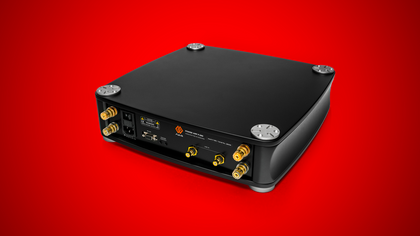
Quiet before the storm
P-280 is a very forthright, precise and detailed power amplifier. Usually such hi-fi virtues are associated with a sound character that’s a bit pushy and in some cases a bit weary on the ears over time. But as with the preamplifier, the musical experience is most important. The music is emotionally rich and has a warmth that doesn’t arise from colouring or filtering, but which is a function of the amplifier’s precision and ability to bring out detail – without becoming too hard or analytical. It may be that the word ‘warmth’ isn’t the correct description. Perhaps I should rather write natural and ear-friendly, and maybe also add ‘credible’ at the end.
The control in the bass is excellent and so forthright and hard-hitting on the touch as any amplifier I have heard in its price range. It’s also capable of playing deep as a well in the bass, and does so in a way that creates engagement and joy of music. The bass is nevertheless clearly audible, and is in no way perceived as too brief or short in the way it sounds. This creates a perfectly luscious soundscape with exceptional detail also in the deeper end of the bass, not to mention that big, wide and splendid mid-bass. When you add an open midrange and a very detailed, spacious and perfectly restrained treble on top, the power amplifier becomes exactly what the preamplifier needs in order to shine.
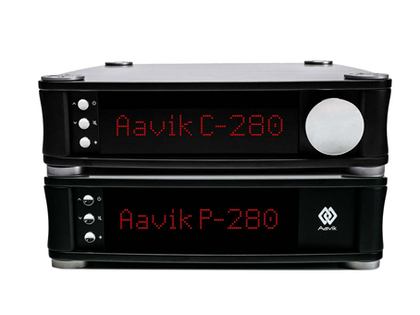
In combination with C-280
The challenge that two products with some of the same sound character is that they in some cases can be too much of a good thing. That is not a concern here. Here there is no hint of colouring, filtering, scenting or added warmth, but rather reproduction that takes excellent care of the original signal. Feel free to call it a kind of honesty in relation to the musical origin that retains both the signal’s content, overtone structure and power in an impressive manner.
I have rarely been served similar amounts of detail and musical content in such a straightforward and natural way. The sound character allows for musical cosiness, but there is also sufficient information to provide experienced hi-fi analysts with what they want.
The way the combo plays also allows for great versatility in the choice of music. There’s hardly a record that should remain untouched, because in the midst of all the technology and precision, the amplifier pair are gratifyingly forgiving. You should of course hook up good electronics to make the most of your investment, but the usual concern that weak or even directly poor recordings will ruin the experience is not as present as I would have expected. The amplifier set’s order, space and control dissolves musical impurities and creates a new joy of listening to banished records. Some remain unsalvageable, of course, but it’s fun to have a set of amplifiers that care more about the music and less about the recording.
And it does look really great when you stack the components on top of each other. The design itself is not particularly quirky, but it’s understandable if some may be of the opinion that Aavik don’t provide a perfect design match with other high-end equipment.
Conclusion
Aavik P-280’s sound character is detailed, transparent and fluid – and very quiet. It’s as pitch black in the background as the preamplifier, and brings along the C-280’s properties in the work of amplifying the signal and preparing it for transmission to the speakers. The power and dynamics are impressive, and the bass foundation is as solid and steady as a rock. An impressive preamplifier and a good power amplifier become a fabulous and well-playing combination.

 Vipps oss en gave: 129702
Vipps oss en gave: 129702![P-280-FRONT[1]](https://img1.custompublish.com/getfile.php/5111033.2411.al7bumkpqqbqwz/0x600/6579585_5111033.png)
